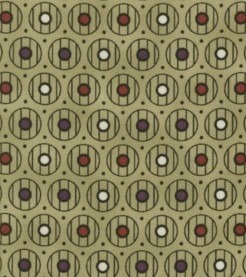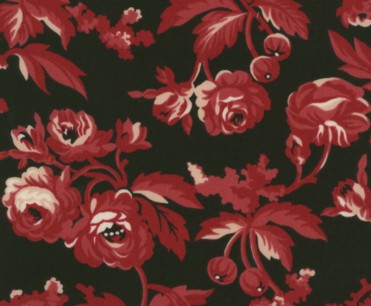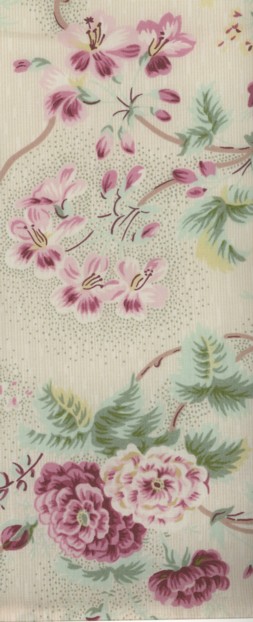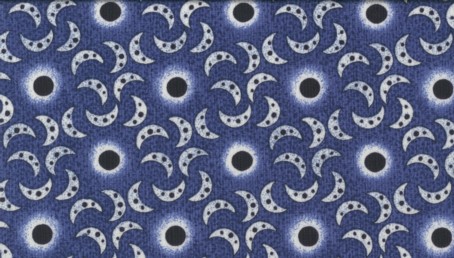
This
new fabric collection is based on a unique style of quilt. Sometimes
this style is called a mosaic, and sometimes a tile quilt, as it
reminds one of the
broken dish mosaics decorating pottery, in fountains, and on tables
today.
The New England Quilt Museum calls their version of it the Boston Pavement Quilt. It
was this quilt that inspired their newest line of fabrics, now being made by
In The Beginning Fabrics. This is a coast to coast venture as they work in conjunction with In the Beginning owner, Sharon Yenter,
who helped choose and design their new line. A portion of the proceeds from
all sales will go directly to the
museum. So this is fabric you can buy for the sake of charity!!
The Boston Pavement Quilt, c.1895
from the collection of the New England Quilt Museum, Lowell, Mass..
Photo and
permission courtesy of NEQM.

A LITTLE HISTORY OF THE TILE
QUILT
A few years back I began to
research tile quilts, as they are
a favorite of mine, but I found almost nothing about them, and no research
project or paper could be found. What I able to ascertain is that this type of
appliqué was more common in England
than in America. In America, they appear in the last quarter of the 19th
century, as compared to the early part of the 19th century in the British Isles.
One American exception may be a quilt
made in Connecticut, called Stone Wall, dated from as early as 1865 to 1890.
You can view this on page 162 of "Quilts and Quiltmakers Covering
Connecticut", which is Connecticut's documentation book. It does not
contain any pictured printed fabrics. It is comprised of 20 tiled blocks and
features a 9-patch on point border all around it. In Ohio's documentation
book, "Quilts in Community, Ohio's Traditions", on page 123, is
a very unusual tile quilt from Medina County. It is jam packed with
picture print motifs and embroidered shapes.. Some of the picture prints are
cut out exactly and others are not. The shapes are irregular, but for the most
part are squares or rectangles and completely cover the top made up of nine
large muslin squares. The maker chose fabrics and embroidered scenes that
reflected what was special to her in her life, like her husband's jewelry
storefront. It is dated 1886-1887 and is called Mother Well's Quilt.
Turning to the earlier versions of this quilt
found in the British Isles, "Quilt Treasures of Great Britain, the
Heritage Search of the Quilter's Guild" pictures several of their
variations of this style on pages 50-55. English quiltmakers would appliqué
irregular shapes and printed motifs onto strips of fabrics on whole cloth size
pieces, in center panels of medallions and into pieced blocks. The earliest
dated one pictured is 1810. They differ from cut-out chintz appliqué quilts
mainly because the motifs are not related to each other to form a large scene
or flowering tree, for example. The appliqués are more like individual
photos like in a scrapbook album. The effect of streets is not a feature of
these quilts, but the overall style and method is the same. In the New jersey
documentation book, "New Jersey Quilts, 1777-1950", on page
104, there is an example of the Scottish version which is dated 1860 on the
quilt itself. It was sent from Galston, Scotland from the maker to her
daughter in NJ. It is set in a medallion format, with plaid fabrics adorning
the inner frames and the appliqué tiles are cut from plaid fabrics too, into
large shapes of various leaves and stems. it's fringed on one side and
unquilted. Two more Scottish quilts are described and pictured on pages 86-88
of "Quilts of the British Isles". They are both in the strip
style with Turkey Red strips in-between the white or light fabric with the appliquéd
scraps scattered about. Both are backed but unquilted.
To make a street tile style quilt, the quilter chooses a particular motif to feature in the
center of the piece, and then builds other shapes, in different fabrics,
around it. Women would cut out a printed lady, or child, or fan, or flower,
some recognizable object from a piece of fabric and appliqué it down near the
center of a muslin block. Next she would pick small calico prints from which
she cut various shapes to appliqué around the picture piece. Some of the
shapes were recognizable, like scissors or a cat, while others were dissimilar
geometric shapes. They were appliquéd in such a way as to leave a 1/8 to ¼ inch space of the muslin
showing on all sides of each piece,
giving the effect of grout or streets. In most cases, the quilt was made from many of
these blocks, each one featuring a minimum of one main picture fabric motif. These were not usually cut
out precisely; some of the background color was left around the rounded edges,
giving an overall round effect. The surrounding tiles pieces were circles,
triangles, rectangles or squares. Often the corners were slightly rounded.
THE COLLAGE COLLECTION OF REPRODUCTION
FABRICS
The NEQM's tile quilt is dated circa 1895. In my estimation, this is a
time-span of variety in reproduction fabrics dating from at least the 1870s
through the 1920s,
as it includes prints on a black background, faux patchwork motifs dating, Garibaldi
prints, all sizes and shapes of floral motifs, geometrics, and soft florals
seen in 1920s colors
and size. In total there are 68 prints in this large
collection. In one of the two major fabric groupings, 36 of the prints are small scale and come
printed with 4 color coordinated prints to each yard.
(It is very French to back a quilt with this quarter fabric style.) There are
three main colorways of each of the different prints which include shades of: red, gold-orange, blue,
(all of these are with black as the second color), pink, brown, purple, and a
French inspired small paisley and other flower motifs in blues, browns and
pinks with light backgrounds. That is only half of the collection. The colors
are rich and vibrant.
 There
are medium and larger scale fabrics as well. The medium scale motifs are
flowers and they are of the type I have been waiting and waiting to see made-
the larger Garibaldi style print (seen on the left) of two shades of red on black floral with a
little touch of white for highlight, not like anything else on the market for
years. It also comes in a two shades of blue on black, and manganese bronze
with pink on dark brown. Absolutely right-on for an 1880s print. Gorgeous and
again, you don't see this size and colorway on the market very often. It was
very popular in end of the century quilts! View the fabrics here There
are medium and larger scale fabrics as well. The medium scale motifs are
flowers and they are of the type I have been waiting and waiting to see made-
the larger Garibaldi style print (seen on the left) of two shades of red on black floral with a
little touch of white for highlight, not like anything else on the market for
years. It also comes in a two shades of blue on black, and manganese bronze
with pink on dark brown. Absolutely right-on for an 1880s print. Gorgeous and
again, you don't see this size and colorway on the market very often. It was
very popular in end of the century quilts! View the fabrics here
In the second major group of fabrics, there are some
pastel floral prints which are feminine in appearance and some strong
geometrics with a masculine flavor. Some prints look like bedroom florals while others
look retro and oh so 50s! See this fabric at top of this page. Both the print
style and the gray-green color were also seen in quilts and homes in the
1920s.
This part of the collection offers a print of large roses in pink, peach and  yellow
colors on a tiny seaweed patterned ground reminiscent of the circa1825 period. The
prints at the end of the century were trying to replicate those of the earlier
years, just as we are now. There IS nothing new under the sun! A smaller, but
still medium sized floral, comes in three pastel colorways on very pale, thinly
stripped grounds. The flowers and leaves come in; aqua with peach, lilac with olive, and rose with mint green.
Yummy! Each of these colorways have seven coordinating fabrics, but not the
least bit "matchy", in small motifs
of a wide variety of looks. The colors of
the lilac and olive set are unique to the reproduction world and may not have
been a color you saw in 1895, but it is a beautiful palette and very useable
today. Or- you can say it faded from a brighter green! The bronze-olive
green was a color used in the 1880s, so it really is acceptable, but
looks later too. View the fabrics here. yellow
colors on a tiny seaweed patterned ground reminiscent of the circa1825 period. The
prints at the end of the century were trying to replicate those of the earlier
years, just as we are now. There IS nothing new under the sun! A smaller, but
still medium sized floral, comes in three pastel colorways on very pale, thinly
stripped grounds. The flowers and leaves come in; aqua with peach, lilac with olive, and rose with mint green.
Yummy! Each of these colorways have seven coordinating fabrics, but not the
least bit "matchy", in small motifs
of a wide variety of looks. The colors of
the lilac and olive set are unique to the reproduction world and may not have
been a color you saw in 1895, but it is a beautiful palette and very useable
today. Or- you can say it faded from a brighter green! The bronze-olive
green was a color used in the 1880s, so it really is acceptable, but
looks later too. View the fabrics here.
Each of these fabrics would make tiles of different sizes and shapes to place
around the center motif to replicate this quilt. NEQM did not let us down, as
the feature fabric is a pre-print of the motifs to cut around and place in the
center of the tile block. It comes in both a black and a beige background
color. The motifs are Victorian, reminiscent period postcards, Valentines and picture books, in
colorful and quaint illustrations. There are fruits, fans, children, animals,
flowers, a good luck charm, and more.
This is a very fun fabric and would not be limited to only this style of quilt. A
crazy quilt could incorporate them. For those who want to make a special
"name it" or "can you find it" quilt for a child, this is
perfect!
Some of the motifs are large, which means the
foundation muslin block could be large, like 14-18 inches. Other motifs are medium or
small, and could be used as an outer tile, as seen in the 1895 quilt. One of
the blocks in that quilt had five small motifs without a large motif in the
center. This block was placed in the center of the quilt. Not every block
contains a printed motif. I think this quilt was made by many different people
in the style of a friendship quilt. There is a pattern for the museum's tile
quilt in their book "The
New England Quilt Museum Quilts" by Jennifer Gilbert, then curator,
now director. The quilt size is 52X82' and the 35 blocks are 11 ½ inches
square. They recommend cutting the square at 13 inches and sizing it after the
appliqués have been attached.

In
the Spring 2005 edition of the magazine "Designer's Quarters", a
more contemporary quilt using these fabrics is given with a pattern. It is a
variation of a pieced basket using the floral fabrics for the base and upper
triangle, with the focus fabric
uncut in the alternate squares, and the sun and moon fabric (seen on the left)
in a wide border
around it all. This article also shows a photo of the entire focus fabric
prints and some close-ups of some of the others prints, but there are so many,
space does not permit showing them all. So go to your quilt shop and ask for this
fabric, or look online, and buy them for yourself and to help the New England
Quilt Museum. Let us keep this quality and quantity of reproduction fabrics
coming from this museum's collections. Show your support- this is a beautiful
line of reproduction fabrics covering a large span of time to suit more than
one of your tastes.
My thanks to:
New England Quilt Museum
In the Beginning Fabrics
Designer's Quarters Magazine |